Enjoy our triplist below! For our tour
description, itinerary, past triplists, dates, fees, and more,
please visit our TOUR PAGE.
Click on the link at right to see this
triplist in printable PDF format with media only on
page 1.

A panoramic view of
the magnificent Machu Picchu ruins with the Urubamba River
valley far below. (Photo by guide Jesse Fagan)
This tour is one of my favorites for many reasons. It indeed
has great birding, plus a visit to the world famous Machu
Picchu ruins, excellent food, and nice accommodations, but
Abra Malaga steals my heart and mind everytime. The view of
Veronica during our hike up to the Polylepis forest, our
descent into the valley, the blue skies and views of the Andes
that roll on forever, and the quietness. That quietness I just
love. Thanks to my fun and energetic group for sharing that
moment with me. I will miss our time together: Nancy, Bill,
Wanda, Ted, Lynn, Martin, Hans, and Ann-Margreth. It was a
great time. Thanks to Lucretia for her excellent guiding, and
thanks for allowing Rocio to come along! She too had a blast.
Birding highlights were many, but the Yungas Pygmy-Owl stole
the show! Nice work team, but especially to Ted for finding
that little guy. Rocio wanted to take him home! Other great
birds we found included Black-and-chestnut Eagle, Andean
Parakeets, an all too brief flyby Maroon-chested Ground-Dove,
Bearded Mountaineer (!) and Sword-billed Hummingbird, Giant
Conebill, Masked Fruiteater, Many-colored Rush-Tyrant (it
ain't over until she sings!), White-winged Diuca-Finch, and
Black Siskin.
Bird On. One Love.
Jesse Fagan aka Motmot
KEYS FOR THIS LIST
One of the following keys may be shown in brackets for
individual species as appropriate: * = heard only, I =
introduced, E = endemic, N = nesting, a = austral migrant, b =
boreal migrant
Anatidae (Ducks, Geese, and Waterfowl)
ANDEAN GOOSE (Chloephaga melanoptera)
TORRENT DUCK
(Merganetta armata)
BLUE-WINGED TEAL
(Anas discors)
CINNAMON TEAL
(Anas cyanoptera)
WHITE-CHEEKED
PINTAIL (Anas bahamensis)
YELLOW-BILLED
PINTAIL (Anas georgica)
PUNA TEAL (Anas puna)
YELLOW-BILLED TEAL
(Anas flavirostris)
RUDDY DUCK
(ANDEAN) (Oxyura jamaicensis
ferruginea)
Cracidae (Guans, Chachalacas, and
Curassows)
ANDEAN GUAN (Penelope montagnii)
Podicipedidae (Grebes)
WHITE-TUFTED GREBE (Rollandia rolland)
Ardeidae (Herons, Egrets, and Bitterns)
FASCIATED TIGER-HERON (Tigrisoma fasciatum)
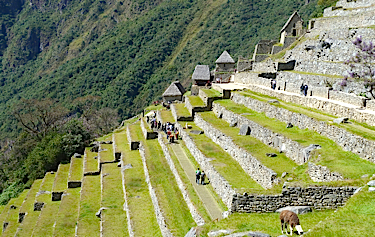
The beautifully
terraced grounds of Machu Picchu, complete with tourist
group and a grazing llama. (Photo by tour participant Bill
Denton)
CATTLE EGRET (Bubulcus ibis)
BLACK-CROWNED
NIGHT-HERON (Nycticorax
nycticorax)
Threskiornithidae (Ibises and Spoonbills)
PUNA IBIS (Plegadis
ridgwayi)
BLACK-FACED IBIS
(BRANICKII) (Theristicus
melanopis branickii)
Cathartidae (New World Vultures)
ANDEAN CONDOR (Vultur gryphus)
Accipitridae (Hawks, Eagles, and Kites)
BLACK-CHESTED BUZZARD-EAGLE (Geranoaetus melanoleucus)
CINEREOUS HARRIER
(Circus cinereus)
HARRIS'S HAWK
(Parabuteo unicinctus)
ROADSIDE HAWK
(Buteo magnirostris)
VARIABLE HAWK
(Buteo polyosoma)
BLACK-AND-CHESTNUT
EAGLE (Spizaetus isidori)
Falconidae (Falcons and Caracaras)
MOUNTAIN CARACARA (Phalcoboenus megalopterus)
AMERICAN KESTREL
(Falco sparverius)
Rallidae (Rails, Gallinules, and Coots)
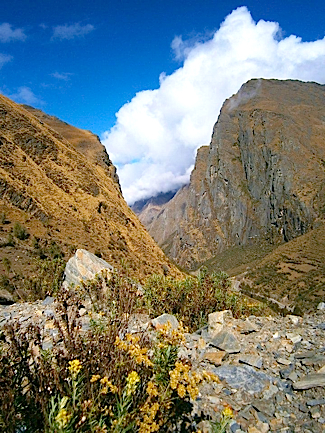
A view of the
dry, rocky outcrops on the west slope of Abra Malaga, home
to endemics like Creamy-crested Spinetail and White-tufted
Sunbeam. (Photo by guide Jesse Fagan)
PLUMBEOUS RAIL (Pardirallus sanguinolentus)
COMMON GALLINULE
(Gallinula galeata)
SLATE-COLORED COOT
(Fulica ardesiaca)
Charadriidae (Plovers and Lapwings)
ANDEAN LAPWING (Vanellus resplendens)
Scolopacidae (Sandpipers and Allies)
GREATER YELLOWLEGS (Tringa melanoleuca)
Laridae (Gulls, Terns, and Skimmers)
ANDEAN GULL (Chroicocephalus serranus)
Columbidae (Pigeons and Doves)
ROCK PIGEON (Columba livia)
SPOT-WINGED PIGEON
(Patagioenas maculosa)
BAND-TAILED PIGEON
(Patagioenas fasciata)
EARED DOVE
(Zenaida auriculata)
MAROON-CHESTED
GROUND-DOVE (Claravis
mondetoura)
BARE-FACED
GROUND-DOVE (Metriopelia
ceciliae)
WHITE-TIPPED DOVE
(Leptotila verreauxi)
Psittacidae (Parrots)
MITRED PARAKEET (Aratinga mitrata)
ANDEAN PARAKEET
(Bolborhynchus orbygnesius)
SPECKLE-FACED
PARROT (PLUM-CROWNED) (Pionus
tumultuosus tumultuosus)
Strigidae (Owls)
YUNGAS PYGMY-OWL (Glaucidium bolivianum)
Caprimulgidae (Nightjars and Allies)
LYRE-TAILED NIGHTJAR (Uropsalis lyra) [*]
Apodidae (Swifts)
WHITE-COLLARED SWIFT (Streptoprocne zonaris)
WHITE-TIPPED SWIFT
(Aeronautes montivagus)
ANDEAN SWIFT
(Aeronautes andecolus)
Trochilidae (Hummingbirds)
GREEN VIOLETEAR (Colibri thalassinus)
SPARKLING
VIOLETEAR (Colibri coruscans)
AMETHYST-THROATED
SUNANGEL (Heliangelus
amethysticollis)
SPECKLED
HUMMINGBIRD (Adelomyia
melanogenys)
LONG-TAILED SYLPH
(Aglaiocercus kingi)
ANDEAN HILLSTAR
(Oreotrochilus estella)
BEARDED
MOUNTAINEER (Oreonympha
nobilis)
[E]
TYRIAN METALTAIL
(Metallura tyrianthina)
WHITE-TUFTED
SUNBEAM (Aglaeactis
castelnaudii) [E]
COLLARED INCA
(GOULD'S) (Coeligena torquata
omissa)
VIOLET-THROATED
STARFRONTLET (Coeligena
violifer)
SWORD-BILLED
HUMMINGBIRD (Ensifera
ensifera)
GREAT SAPPHIREWING
(Pterophanes cyanopterus)
CHESTNUT-BREASTED
CORONET (Boissonneaua
matthewsii)
WHITE-BELLIED
WOODSTAR (Chaetocercus
mulsant)
WHITE-BELLIED
HUMMINGBIRD (Amazilia
chionogaster)
GREEN-AND-WHITE
HUMMINGBIRD (Amazilia
viridicauda) [E]
Momotidae (Motmots)
ANDEAN MOTMOT (Momotus aequatorialis)
Picidae (Woodpeckers)
OCELLATED PICULET (Picumnus dorbignyanus)
GOLDEN-OLIVE
WOODPECKER (Colaptes
rubiginosus)
ANDEAN FLICKER
(Colaptes rupicola)
Furnariidae (Ovenbirds and Woodcreepers)
CREAM-WINGED CINCLODES (Cinclodes albiventris albiventris)
WHITE-WINGED
CINCLODES (Cinclodes
atacamensis)
WREN-LIKE RUSHBIRD
(Phleocryptes melanops)
TAWNY
TIT-SPINETAIL (Leptasthenura
yanacensis)
WHITE-BROWED
TIT-SPINETAIL (Leptasthenura
xenothorax) [E]
AZARA'S SPINETAIL
(Synallaxis azarae)
MARCAPATA
SPINETAIL (Cranioleuca
marcapatae)
[E]
LINE-FRONTED
CANASTERO (Asthenes
urubambensis)
STREAK-BACKED
CANASTERO (Asthenes wyatti)
STREAK-THROATED
CANASTERO (Asthenes humilis)
PUNA THISTLETAIL
(Asthenes helleri)
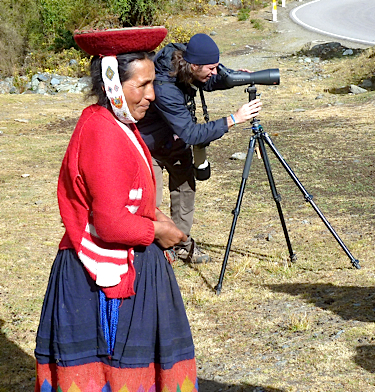
A local resident
waits anxiously, wondering if Jesse will get the endemic
Chestnut-breasted Mountain-Finch in the scope before it
flies (he did!) (Photo by tour participant Bill Denton)
RUSTY-FRONTED CANASTERO (Asthenes ottonis)
[E]
STREAK-FRONTED
THORNBIRD (Phacellodomus
striaticeps) [*]
PEARLED TREERUNNER
(Margarornis squamiger)
STREAKED XENOPS
(Xenops rutilans)
Thamnophilidae (Typical Antbirds)
VARIABLE ANTSHRIKE (Thamnophilus caerulescens)
Grallariidae (Antpittas)
STRIPE-HEADED ANTPITTA (Grallaria andicolus punensis)
RUFOUS ANTPITTA
(Grallaria rufula occabambae) [*]
Rhinocryptidae (Tapaculos)
TRILLING TAPACULO (Scytalopus parvirostris) [*]
PUNA TAPACULO
(Scytalopus simonsi)
Tyrannidae (Tyrant Flycatchers)
WHITE-BANDED TYRANNULET (Mecocerculus stictopterus)
WHITE-THROATED
TYRANNULET (Mecocerculus
leucophrys)
ASH-BREASTED
TIT-TYRANT (Anairetes alpinus)
UNSTREAKED
TIT-TYRANT (Anairetes
agraphia) [E*]
YELLOW-BELLIED
ELAENIA (Elaenia flavogaster)
WHITE-CRESTED
ELAENIA (Elaenia albiceps)
HIGHLAND ELAENIA
(Elaenia obscura obscura)
SIERRAN ELAENIA
(Elaenia pallatangae)
TORRENT TYRANNULET
(Serpophaga cinerea)
STREAK-NECKED
FLYCATCHER (Mionectes
striaticollis)
MOTTLE-CHEEKED
TYRANNULET (Phylloscartes
ventralis)
SCLATER'S
TYRANNULET (Phyllomyias
sclateri)
ASHY-HEADED
TYRANNULET (Phyllomyias
cinereiceps)
MANY-COLORED RUSH
TYRANT (Tachuris rubrigastra)
COMMON
TODY-FLYCATCHER (Todirostrum
cinereum)
YELLOW-OLIVE
FLYCATCHER (ANDES) (Tolmomyias
sulphurescens peruvianus)
CINNAMON
FLYCATCHER (Pyrrhomyias
cinnamomeus)
SMOKE-COLORED
PEWEE (Contopus fumigatus)
BLACK PHOEBE
(WHITE-WINGED) (Sayornis
nigricans latirostris)
WHITE-WINGED
BLACK-TYRANT (Knipolegus
aterrimus)
TACZANOWSKI'S
GROUND-TYRANT (Muscisaxicola
griseus)
CINEREOUS
GROUND-TYRANT (Muscisaxicola
cinereus)
OCHRE-NAPED
GROUND-TYRANT (Muscisaxicola
flavinucha)
RUFOUS-NAPED
GROUND-TYRANT (Muscisaxicola
rufivertex)
STREAK-THROATED
BUSH-TYRANT (Myiotheretes
striaticollis)
RUFOUS-BREASTED
CHAT-TYRANT (Ochthoeca
rufipectoralis)
BROWN-BACKED
CHAT-TYRANT (Ochthoeca
fumicolor)
WHITE-BROWED
CHAT-TYRANT (Ochthoeca
leucophrys)
DUSKY-CAPPED
FLYCATCHER (Myiarchus
tuberculifer atriceps)
GOLDEN-CROWNED
FLYCATCHER (Myiodynastes
chrysocephalus)
STREAKED
FLYCATCHER (Myiodynastes
maculatus)
TROPICAL KINGBIRD
(Tyrannus melancholicus)
Cotingidae (Cotingas)
MASKED FRUITEATER (Pipreola pulchra) [E]
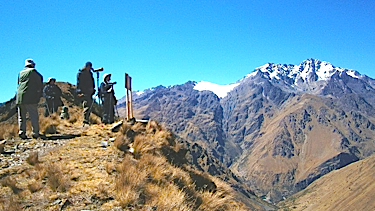
Birding the
polylepis forest at Abra Malaga will leave you breathless-
quite literally, as you'll be up over 14000 feet in
elevation! (Photo by guide Jesse Fagan)
RED-CRESTED COTINGA (Ampelion rubrocristatus)
ANDEAN
COCK-OF-THE-ROCK (Rupicola
peruvianus)
Tityridae (Tityras and Allies)
BARRED BECARD (Pachyramphus versicolor)
Vireonidae (Vireos)
BROWN-CAPPED VIREO (Vireo leucophrys)
RED-EYED VIREO
(MIGRATORY CHIVI) (Vireo
olivaceus chivi)
Corvidae (Crows, Jays, and Magpies)
GREEN JAY (INCA) (Cyanocorax yncas yncas) [*]
Hirundinidae (Swallows)
BLUE-AND-WHITE SWALLOW (Pygochelidon cyanoleuca)
BROWN-BELLIED
SWALLOW (Orochelidon murina)
Troglodytidae (Wrens)
INCA WREN (Pheugopedius
eisenmanni)
[E]
HOUSE WREN
(Troglodytes aedon)
MOUNTAIN WREN
(Troglodytes solstitialis)
GRAY-BREASTED
WOOD-WREN (Henicorhina
leucophrys)
Cinclidae (Dippers)
WHITE-CAPPED DIPPER (Cinclus leucocephalus)
Turdidae (Thrushes and Allies)
ANDEAN SOLITAIRE (Myadestes ralloides)
WHITE-EARED
SOLITAIRE (Entomodestes
leucotis)
SLATY THRUSH
(Turdus nigriceps)
GREAT THRUSH
(Turdus fuscater)
CHIGUANCO THRUSH
(Turdus chiguanco)
Motacillidae (Wagtails and Pipits)
PARAMO PIPIT (Anthus bogotensis)
Parulidae (New World Warblers)
TROPICAL PARULA (Setophaga pitiayumi)
CITRINE WARBLER
(Myiothlypis luteoviridis)
RUSSET-CROWNED
WARBLER (Myiothlypis
coronatus)
SLATE-THROATED
REDSTART (Myioborus miniatus)
SPECTACLED
REDSTART (Myioborus
melanocephalus)
Thraupidae (Tanagers and Allies)
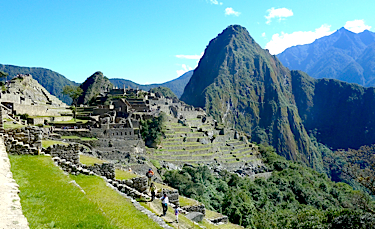
Another view of
Machu Picchu; it's easy to understand why it was named one
of the "New Seven Wonders of the World." (Photo by tour
participant Bill Denton)
SLATY TANAGER (Creurgops dentatus)
BLACK-CAPPED
HEMISPINGUS (WHITE-BROWED) (Hemispingus
atropileus auricularis)
PARODI'S
HEMISPINGUS (Hemispingus
parodii) [E]
SUPERCILIARIED
HEMISPINGUS (Hemispingus
superciliaris)
OLEAGINOUS
HEMISPINGUS (Hemispingus
frontalis)
RUST-AND-YELLOW
TANAGER (Thlypopsis ruficeps)
CINEREOUS CONEBILL
(Conirostrum cinereum)
BLUE-BACKED
CONEBILL (Conirostrum
sitticolor)
CAPPED CONEBILL
(Conirostrum albifrons)
WHITE-BROWED
CONEBILL (Conirostrum
ferrugineiventre)
GIANT CONEBILL
(Oreomanes fraseri)
TIT-LIKE DACNIS
(Xenodacnis parina)
PLUSHCAP (Catamblyrhynchus diadema)
BLUE-GRAY TANAGER
(Thraupis episcopus)
PALM TANAGER
(Thraupis palmarum)
BLUE-AND-YELLOW
TANAGER (Thraupis bonariensis)
SCARLET-BELLIED
MOUNTAIN-TANAGER (Anisognathus
igniventris)
CHESTNUT-BELLIED
MOUNTAIN-TANAGER (Delothraupis
castaneoventris)
FAWN-BREASTED
TANAGER (Pipraeidea
melanonota)
SAFFRON-CROWNED
TANAGER (Tangara
xanthocephala)
GOLDEN-NAPED
TANAGER (Tangara ruficervix)
BLUE-NECKED
TANAGER (Tangara cyanicollis)
BLUE-AND-BLACK
TANAGER (Tangara vassorii)
SILVERY TANAGER
(Tangara viridicollis)
BLUE DACNIS
(Dacnis cayana)
GOLDEN-BILLED
SALTATOR (Saltator
aurantiirostris)
Emberizidae (Buntings, Sparrows and
Allies)
PERUVIAN SIERRA-FINCH (Phrygilus punensis)
PLUMBEOUS
SIERRA-FINCH (Phrygilus
unicolor)
ASH-BREASTED
SIERRA-FINCH (Phrygilus
plebejus)
WHITE-WINGED
DIUCA-FINCH (Diuca
speculifera)
CHESTNUT-BREASTED
MOUNTAIN-FINCH (Poospiza
caesar)
[E]
YELLOW-BELLIED
SEEDEATER (Sporophila
nigricollis)
BAND-TAILED
SEEDEATER (Catamenia analis)
PLAIN-COLORED
SEEDEATER (Catamenia inornata)
DULL-COLORED
GRASSQUIT (Tiaris obscurus)
BLACK-THROATED
FLOWERPIERCER (Diglossa
brunneiventris)
RUSTY
FLOWERPIERCER (Diglossa
sittoides)
MASKED
FLOWERPIERCER (Diglossa
cyanea)
GREENISH
YELLOW-FINCH (Sicalis
olivascens)
CHESTNUT-CAPPED
BRUSH-FINCH (Arremon
brunneinucha) [*]
WHITE-BROWED
BRUSH-FINCH (Arremon
torquatus)
CUZCO BRUSH-FINCH
(Atlapetes canigenis) [E]
RUFOUS-COLLARED
SPARROW (Zonotrichia capensis)
Cardinalidae (Cardinals and Allies)
BLACK-BACKED GROSBEAK (Pheucticus aureoventris)
Icteridae (Troupials and Allies)
YELLOW-WINGED BLACKBIRD (Agelasticus thilius)
DUSKY-GREEN
OROPENDOLA (Psarocolius
atrovirens)
Fringillidae (Siskins, Crossbills, and
Allies)
THICK-BILLED EUPHONIA (Euphonia laniirostris)
BLUE-NAPED
CHLOROPHONIA (Chlorophonia
cyanea)
HOODED SISKIN
(Spinus magellanicus)
BLACK SISKIN
(Spinus atratus)
NORTHERN MOUNTAIN
VISCACHA (Lagidium peruanum)
Totals for the tour: 194 bird taxa and 1 mammal taxa






